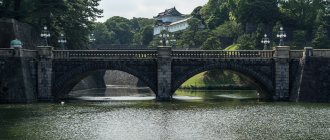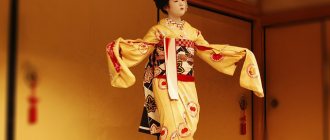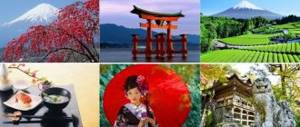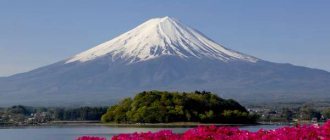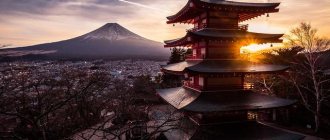Japan on the world map
Japan - view larger map
Japan is located on almost 7,000 large and small islands, which are washed by the Pacific Ocean, East China, Japan, Aki and Okhotsk seas. 97% of the country's total area is occupied by the four largest islands: Honshu, Hokkaido, Shikoku and Kyushu.
Japan on the world map
Japan got its name from the ancient Japanese “Yamata”, which translated means “country of mountain people”. The total area of this island state is 377835 km2.
Japan's northern borders separate it from Russia (Sakhalin, the Kuril Islands), its southern borders from the Philippines, and its western and northwestern borders from China and South Korea.
More than 127 million people live on the islands, of which 99% are Japanese. Another 0.5% each accounts for the Koreans and Chinese with the Ainu (remnants of the indigenous population). Almost all residents speak Japanese, which is the official language.
The form of government of the state is a constitutional monarchy, and its head is the emperor, who has no real power. It is rather a symbol of the unity of the nation.
Religions in Japan: Buddhism, Shinto, Christianity. In general, the Japanese are very warm towards any religion, and never interfere with anyone’s communication with their gods, of course, provided that your prayer does not disturb the peace and comfort of those around you.
Legends of a small island
Enoshima's stunning landscapes feature colorful plains and massive hills, one of which is home to Ryukoji, an ancient Buddhist temple that carefully preserves the secrets of the monks who once lived here. A few meters from the shrine there are graves in which rest the soldiers of the Mongol Khan Kublai Khan, who tried to break
bring Japan under his rule.
Hidden in one of the secluded corners of the amazing island are mysterious caves created by nature itself. According to legend, they were the refuge of the goddess Benten herself (the patroness of theater and music), who later became the wife of a five-headed dragon.
Above the amazing landscapes of the picturesque island rises a man-made miracle that has become a symbol of Enoshima - the observatory lighthouse. It was created several centuries ago and is an inaccurately scaled-down copy of its huge Alexandrian counterpart. To enjoy the amazing view from the lighthouse, you will have to climb a long spiral staircase. But it is not difficult, and the effort is worth it to see the beauty of the fabulous beaches and appreciate the luxury of the magnificent nature of Enoshima and the nearby island of Honshu. In the evening twilight, the mysterious lighthouse is a mesmerizing sight. Flickering lights reflected in the dark surface of the water excite the imagination, bringing to life the legends with which the tiny island is so rich.
National flag of Japan - Sunny
The flag of Japan is simple, and, probably, that’s why it’s very memorable: a red circle, representing the rising sun, in the center of a white cloth.
According to ancient legend, the flag tradition dates back to the Mongol invasion of the country in the 13th century. Buddhist monks presented it as a gift to the Japanese emperor, as a direct descendant of the Sun Goddess.
"Nisshoki" - "sun flag" - is the official name of the state standard. But a more common option is “Hinomaru” - “sun disk”.
“Hinomaru” received its state status after 1868, during the era of national restoration.
The flag is a real shrine for any Japanese. Just like the Emperor.
Why is China now more often called China?
In all corners of the earth, China is known as China. This combination is Latin, and has several official versions of its origin:
- back in the 200s BC, which marked the heyday of the silk trade with the ancient world, the Chinese called themselves Qin from the ruling Qin dynasty, and in the records of those times they recorded themselves as Cina;
- the second opinion says that the country took the name in honor of the Jing kingdom, which once existed on these lands;
- It is widely believed that the traveler Afanasy Nikitin brought it with him, who was struck by the high quality of Chinese porcelain in the south of the country, which was exported in large quantities to India. Brittle material is also called China;
- the famous traveler Marco Polo, in his notes and the “Book of Wonders of the World,” spoke of the Chinese land as Chin.
Climate of Japan - summer is like summer, winter is like winter
The climate in Japan varies depending on the latitude in which a particular territorial area is located. The northern part is characterized by moderation, the southern part is characterized by subtropics and monsoon tropics.
Sufficiently hot summers throughout the country cause the thermometer to rise from +30°C to +38°C. At the same time of year, air humidity is very high here, because... maximum precipitation occurs. Hurricanes and typhoons are common. Temperatures in winter range from -5°C to -15°C, on the Ryukyu Archipelago – up to + 16°C. At the same time, quite a lot of snow falls.
Hot and humid summers contribute to the diversity of the plant world. The country's flora is represented by more than 17 thousand plant species, the most famous of which is sakura - the national symbol of the Japanese. Many tourists specifically buy event tours to watch the cherry blossoms.
The fantastically beautiful annual (in April) flower festivals here are dedicated to the seasonal multicolor and riot of colors.
September is the logical start of autumn with mild temperatures and acceptable precipitation.
Planet Japan
Exciting and varied tours to Japan turn a holiday in this country into an unforgettable adventure. Any Asian country is exotic. But a trip to the Land of the Rising Sun can only be compared with a trip to another planet))))) it is so original and unique. I propose a film from the Golden Globe series about Japan.
— —
The Japanese carefully and reverently preserve their identity, not allowing outside influences to penetrate their national culture. This country harmoniously and wisely combines ancient traditions and the heritage of its ancestors with the highest achievements in economics and production. The simplest example is the classic theater of the Land of the Rising Sun.
Japan is rightfully considered the healthiest country on the planet. Many healing and rejuvenating techniques originated from here. There are many healing hot springs in the country, where a full range of health services are provided. Even 70-80 year olds enjoy going on the best holiday - to the national onsen baths.
Those who are planning an active holiday here should consider Fuji, where they can go paragliding or try to conquer Asso, a volcano with the world’s highest caldera.
Skiers can go to the resorts of the island. Hokkaido, and divers - on the coast of the island. Okinawa.
For tourists interested in history and culture, I can suggest Kyoto. And to everyone, without exception, Tokyo is the capital of Japan, where centuries-old traditions and modernity merge together.
A favorite place for tourists who come here is the White Heron Castle, one of the main cultural and historical attractions of the country. The castle is represented by a temple complex surrounded by a labyrinth garden.
Museums in Japan are, for the most part, treasuries located in temples and holy places. Among them: Miyohon Temple, Meiji Treasury Museum, etc. In addition to them, it is worth seeing:
- National Museum and Museum of Calligraphy;
- Museum of Japanese Folk Art and National Museum of Western Art;
- National Science Museum and Art Museum.
In general, the Land of the Rising Sun has a rich history shrouded in many secrets and legends, which the Japanese do not share with every foreigner. But how much secret knowledge the ancient Japanese possessed... No one can even say approximately how much they actually knew. I offer you an interesting film on the topic of ancient knowledge in Japan.
—
—
Here are a few more facets of this mysterious and beautiful country.
Interesting from the point of view of history and architecture are:
- Imperial Palace in Tokyo;
- many beautiful cities, including Ibusuki, Nara, Hiroshima, Osaka;
- Buddhist temples, the main one among which is Rakanji;
- capital television tower, the height of which is 333 m;
- Nijo Castle;
- Katsura Palace;
- Nagoya Castle;
- ancient tombs of the imperial dynasty;
- Asakusa Kannon, Atsuta and Isha temples are the oldest Shinto shrines;
- beautifully maintained gardens, parks, etc.
In the city of Yokohama you will get acquainted with modern Japan, its skyscrapers propped up by clouds and the achievements of scientific and technological progress.
The beaches on the islands are undoubtedly also at the highest level. But visiting this country is unthinkable without combining a seaside holiday with getting to know the local culture and attractions.
What other names does China have?
“TianXia” is what their country sounds like to the Chinese themselves. To themselves they say zhongguoren - residents of the Middle State. The great Asian country is endowed with a special meaning, it is solemnly called: Yuan - Main, Ming - Light, Qing - Pure.
As described earlier, in addition to the “Celestial Empire”, the country was nicknamed “Zhong Guo” - the middle state. The concept “Sykhai”, meaning the land between 4 seas, is also widespread among the people. A rare definition of Zhonghua is found - the Middle Blooming or “Huaxia”, which, like the Celestial Empire, is divided into two parts, the first of which means “lush and blooming”, and the second speaks of the ruling Xia dynasty.
National language and religion, cultural characteristics
Japanese does not belong to any language group and is considered one of the most difficult to learn.
The main national religion is Shintoism, from which the rather pronounced nationalism of the Japanese originates. According to religious teachings, the main deity Kami did not create all people, but exclusively the Japanese. Representatives of the imperial family are supposedly direct descendants of the supreme goddess. Therefore, a change in the ruling dynasty must not be allowed, otherwise the gods will turn away from the state.
Japanese women are beautiful and mysterious. Photo: flickr.com/BillGreen
Speaking about Japanese culture, one cannot ignore the following symbols, known throughout the world.
- the national costume , kimono, along with European clothing. There are different types of kimonos for indoors and outdoors. Most often it is worn on holidays and special occasions.
- Karate in Japan is not just a type of fighting, but a whole system of philosophy and values. This is an art that strengthens the body and spirit. Its study lasts a lifetime.
- Tanka and haiku (haiku) are the oldest poetic genres of the Japanese. The first - short songs of five lines - were usually dedicated to nature and its phenomena, for example, the seasons. Three-verse haiku is a later genre. Their authors are called haijin, and the most famous of these poets is Matsuo Basho. Back in the 17th century, he filled these short poems with philosophical content.
- very important for the Japanese. This is a whole ritual of cleansing and relaxation, which follows strict rules.
- Sushi is a traditional Japanese dish of rice with seafood and vinegar seasoning. Since the 80s, this dish has become popular all over the world.
- Japanese anime animation is noticeably different from Western animation. This genre is characterized by the seriousness of the plots. By the appearance of the hero one can draw a conclusion about his character. For example, kind and cheerful characters have large and shiny eyes, while evil and withdrawn characters have narrow or half-closed ones. The mood and emotions of each character are also carefully thought out and expressed in graphic ways. Anime is produced not only for children, but also for teenagers and adults.
- Sumo wrestling is one of the oldest symbols of Japan. At the same time, it is a martial art, a sport, and a spectacular pop performance.
Russian-Japanese relations
Throughout the twentieth century, relations between Russia and Japan developed in different ways - there were wars, and periods of calm and mutually beneficial relations. The main point of contention between the neighboring powers has always been the Kuril Islands and the southern part of Sakhalin, which the Japanese side considers to be their historical territories. Now Japan demands the return of the four southern islands of the Kuril chain (Iturup, Kunashir, Shikotan, Habomai), and recognizes Sakhalin as completely Russian territory.
The modern achievements of the Japanese economy inspire admiration and respect. For Russia's economic development, it is important to study and adopt the experience of such successful countries as Japan.
Natural resources and the country's economy
Only 13% of the archipelago's total land is suitable for agriculture. At the same time, the state provides itself with 70% of its own products. The main crops grown are rice, citrus fruits, sugar cane, and potatoes.
Sakura is one of the symbols of the country. Kitanomaru Park in Chiyoda-ku in Tokyo. Photo: flickr.com/YoshikazuTAKADA
The natural resources of the islands are scarce. There are minor deposits of coal, oil, and metal ores. In the first half of the twentieth century, Japan waged wars of conquest, thus trying to compensate for the lack of its own natural resources.
In the mid-1950s, an unprecedented rise in the country's economy began, which is called the “Japanese Economic Miracle.” The reasons are considered to be:
- Revision of the state policy of economic development - reduction of the share of the mining industry and heavy industry, reorientation towards knowledge-intensive production.
- Education has been elevated to the rank of a cult here, so the Japanese study continuously and constantly throughout their lives.
- Development of our own science.
- Effective use of foreign technologies. The Japanese are finalizing them and quickly implementing them.
- Very responsible attitude towards work and duty to the state. From childhood, Japanese people, especially boys, are instilled with the idea of the predominance of public interests over personal ones.
Japanese technology is in demand all over the world. Photo: flickr.com/ToshihiroGamo
Now Japan is one of the leaders in the development and implementation of high technologies. They are used in industries such as:
- production of cars, computers, telephones, household appliances;
- robotics;
- medicine;
- space research.


